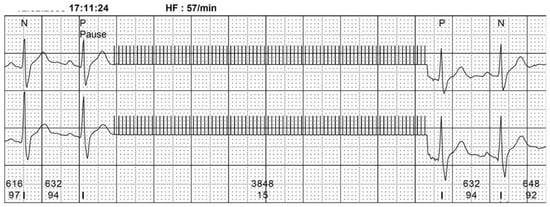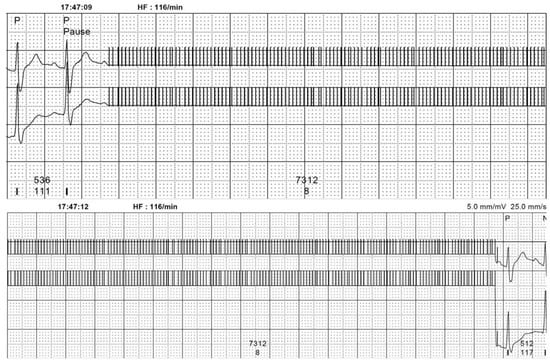Case description
A 67-year-old patient with complete right bundle block in the 12-lead ECG underwent an ambulatory electrocardiographic monitoring (AEM) in order to exclude relevant arrhythmias after a syncope. In the patient diary only the ordinary daily activities without any specific symptoms were reported. However, the evaluation of the AEM revealed two episodes of sinus arrest of four and seven seconds duration each, together with a possible artefact (Figure 1 and Figure 2).

Figure 1.
Pseudo sinus pauses with regular spikes due to interference with electronic article surveillance systems.

Figure 2.
Pseudo sinus pauses with regular spikes due to interference with electronic article surveillance systems.
The answer comes with a thorough inspection of the diary. Between 17:15 and 17:45 the patient was shopping in a multimedia store. We thus suspected artefact sensing during the passage through the theft-protection device at the entrance to the store and later at the cashier desk.
Comments
AEM is used in clinical practice as a means of detecting, documenting, and characterising cardiac arrhythmias []. Electrocardiographic artefacts can occur during AEM and can lead to inappropriate interpretation and may result in severe diagnostic errors []. Electronic article surveillance (EAS) systems are widely implemented in public spaces and can adversely affect the performance of pacemakers and implantable cardioverter defibrillators []. Our case shows a pseudo sinus arrest due to EAS. In order to rule out misinterpretation which can lead to the improper recommendation of a cardiac pacemaker, there are diagnostic clues [] which can help to identify pseudosinus pauses. These clues (unchanged patient sinus rhythm; sudden beginning and end; isoelectric noise signal; R-R interval not modified after the false “arrest”) were all observed in our case. Furthermore, this case shows the importance of a correct daily diary report in order to help the physician to make a correct diagnosis.
References
- Kadish, A.H.; Buxton, A.E.; Kennedy, H.L.; et al. ACC/AHA Clinical competence statement on electrocardiography and ambulatory electrocardiography. A report of the ACC/AHA/ACPASIM Task Force on Clinical Competence (ACC/AHA Committee to develop a clinical competence statement). Circulation. 2001, 104, 3169–3178. [Google Scholar] [PubMed]
- Marquez, M.F.; Colin, L.; Guevara, M.; Iturralde, P.; Hermosillo, A.G. Common electrocardiographic artifacts mimicking arrhythmias in ambulatory monitoring. Am Heart J. 2002, 144, 187–197. [Google Scholar] [CrossRef] [PubMed]
- Gimbel, J.R.; Cox, J.W. Electronic article surveillance systems and interactions with implantable cardiac devices: Risk of adverse interactions in public and commercial spaces. Mayo Clin Proc. 2007, 82, 318–322. [Google Scholar] [CrossRef] [PubMed]
© 2008 by the authors. Licensee MDPI, Basel, Switzerland. This article is an open access article distributed under the terms and conditions of the Creative Commons Attribution (CC BY) license (https://creativecommons.org/licenses/by/4.0/).